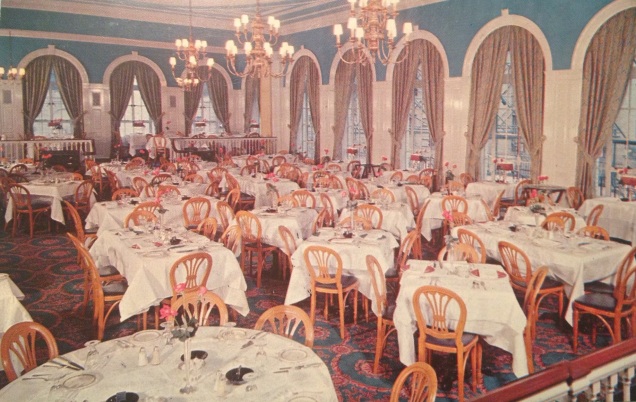Another trip to the Antiques Garage Flea Market in Chelsea had me browsing through postcards of old New York—this time from a vendor with a smaller, more modern selection (and by that I mean 1960s instead of 1910s). Images of long-shuttered New York restaurants captured my attention, and for $3, I walked away with three postcards:
- Castleholm Restaurant, 344 W. 57th Street, with a 1944 postmark
- Whyte’s, 344 W. 57th Street, with a 1963 postmark
- Stockholm Restaurant, 151 W. 51st Street, with no postmark
No, I didn’t make a typo. I realized when I looked more closely at home that I happened to buy two postcards from two restaurants that occupied the same address during two different decades. Among the three restaurants, Whyte’s was by far the best known.
According to an April 21, 1971, article in the New York Times, Edward E. White opened Whyte’s (with a different spelling to differentiate from the many restaurants operated under the name “White”) at 145 Fulton St., between Broadway and Nassau, in 1908, four years after moving to New York from St. Louis.
Built in a kind of Alpine chalet style, Whyte’s strove to retain an Old-World aura, with its dark paneling, gilt-framed portraits, and long oak bar with well-shined brass spitoons.
The bar was a famous watering spot for downtown executives, with groups of insurance men, stockbrokers and politicians taking what seemed to be the assigned places at the rail.
The restaurant’s specialty of the house was finnan haddie, but some long-time afficionados said that the homemade rum raisin ice cream was Whyte’s chef d’oeuvre.
Women were never much in evidence, but unlike other restaurants of its type, Whyte’s never banned them. “I think it was the bar right out in the dining room that might have discouraged them,” Mr. [George] Macris [the manager] said, adding: “But we had plenty of loyal women customers.”
In 1929, Whyte’s “joined the uptown trend,” according to the Times, moving to 5th Avenue and 43rd Street, in the basement of the new Lefcourt National Building. The Fulton Street location became known as Woolley’s, run by management from the Waldorf-Astoria, then on Fifth Avenue and slated for demolition to make way for the Empire State Building. Several months later, the company operating Woolley’s sold its lease, and the restaurant became known as Willard’s. The new restaurant failed, and Whyte’s moved back to Fulton Street after its uptown venture also failed.
Raymond Hopper, a manager for the Whyte family, took ownership of the restaurant in the 1940s. Around 1954-55 (I can’t find this date in the Times myself; I’m crediting this site with the date), Whyte’s opened a second location at 344 West 57th Street.
The Times doesn’t offer much information about the new location, but a Nov. 15, 1963, directory to dining in the Times gave the Fulton Street location the following review:
There is an engaging, turn-of-the-century charm about Whyte’s, and the fish, particularly the finnan-haddie in heavy cream (listed as à la Whyte), is remarkably good. Dishes other than fish and sea food are not of equal stature. There is an à la carte menu for both lunch and dinner with main courses from about $2.35 to $4.25. Cocktails, wines. Closed Saturday and Sunday.
The Fulton Street location, at that time one of the longest operations under the same management, closed in 1971 after it was “outbid so fantastically” and unable to renew its lease, “an apparent victim of the financial recession.” The Times reported: “The manager said the restaurant’s 150 employes were notified of the closing at 2:30 P.M. on Friday. ‘Some of them cried like babies,’ Mr. Macris said. ‘A few have been here 38 years.'”
The postcard I picked up Sunday depicts the dining room of the West 57th Street location—again, very little information about this location online. The back of the postcard says that Whyte’s is “famous for its Beefeater Martini, charcoal broiled steaks, seafood and curried dishes. Your host—Ray Hopper.”
Hopper died April 28, 1971, at the age of 63, just 8 days after the Fulton Street location closed its doors. He had also been a food purchasing agent for the Hamburg-American line, owner of Hofbrau Restaurant in Hoboken, and food purchasing consultant to the late Lucius Boomer, head of the Hotel Waldorf-Astoria Corporation, and to the Savarin Restaurant chain, according to his obituary in the Times.
















